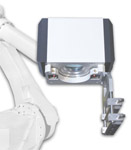14 July 2014
Scan System Teaches Robots How to Take Aim
High-power welding with online seam tracking proves its mettle in the automotive industry
 At LASYS 2014 in Stuttgart, laser positioning and deflection technology leader SCANLAB AG, together with its subsidiary Blackbird Robotersysteme GmbH, presented an industry-proven system solution for robot-assisted 3D scanner welding. The system's key advantage lies in how it combines flexible industrial robots with high-dynamics scanners. This combination enables complex on-the-fly welding operations – which means welding during robotic motion – now for the first time with online tracking of position-critical seams. The system has already proven its impressive capabilities in the automotive industry.
At LASYS 2014 in Stuttgart, laser positioning and deflection technology leader SCANLAB AG, together with its subsidiary Blackbird Robotersysteme GmbH, presented an industry-proven system solution for robot-assisted 3D scanner welding. The system's key advantage lies in how it combines flexible industrial robots with high-dynamics scanners. This combination enables complex on-the-fly welding operations – which means welding during robotic motion – now for the first time with online tracking of position-critical seams. The system has already proven its impressive capabilities in the automotive industry.
Process technology's speed and precision requirements continue to press ahead, particularly in the area of automation. Across numerous sectors, the response is increased reliance on industrial robots for specific operations. Precisely to better harness the strengths of such robots – six degrees of freedom and a large working field of several meters – SCANLAB and Blackbird have developed a system solution that gives robots speed and highest accuracy in welding. With the intelliWELD high-power scan head and the RobotSyncUnit controller as its main components, the system was presented at Lasys. In cooperation with BMW, the system was enhanced for position-critical seams via a coaxial illumination unit and a camera system by Lessmüller Lasertechnik GmbH, and successfully placed into series production.
Practical Test: Fillet Welding of Car Doors
Remote laser welding of galvanized steel surfaces (e.g. car doors) has required creation of a defined gap between the surfaces for degassing zinc. This time-intensive and costly preparatory step can be avoided by switching to alternative joint geometries, such as fillet seams. However, they require a level of precision during laser beam positioning that is unattainable without real-time sensors and control.
"This is precisely where our system solution comes in. We wanted robot-based scanner welding advantages – high flexibility with maximum efficiency – to also be made available for position-critical seams," is how Dr. Wolfgang Vogl, CEO of Blackbird Robotersysteme GmbH, explains the concept. "The system's intelligent control technology considers the robot's motion path and positions the scan mirrors in accordance with sensor data to enable not only complex welding operations, but also simultaneous correction of positioning inaccuracies during the motion sequence." For the first time, this technology can meet fillet welding precision requirements in a remote process. Here, the significant advantage of short process times is further enhanced by intelligent, easily programmable control.
Carefully-Conceived and Focused Down to the Last Detail
The intelliWELD scan system's optical design is an essential prerequisite for this achievement. The head offers two ports that can serve as separate inputs and outputs for coaxial sensors – camera monitoring and illumination in this case. Moreover, a prefocus optic is used in place of an objective to attain sharp camera imaging free of chromatic aberration throughout the entire working volume. And maximum transmission of sensor wavelengths is guaranteed.
BMW's industrial application of scanner technology for Mini door fabrication drastically reduced process times, while seam tracking ensured robust and precise welding of front fillet seams. For sure, other auto manufacturing applications can profit from this integrated system solution, too, as can automotive suppliers and any high volume industry requiring precisely-aimed welding of defined seams.
- Contact Information
- Name: Erica Hornbogner
- Email: info@scanlab.de
- Website: www.scanlab.de

